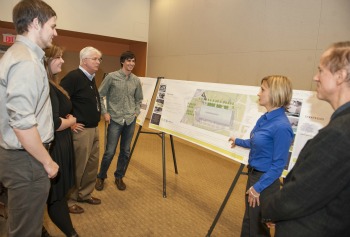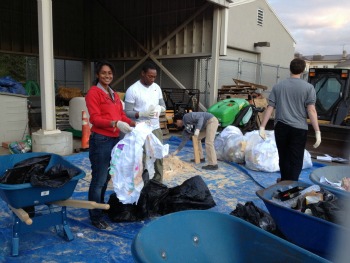
April 8, 2013
Architecture Building Expected to be First in Nation LEED Certified by Students


The Catholic University campus has become a living laboratory for students in a new course offered by the architecture school this year. Students from CUA's LEED Lab met last week with University administrators and staff to review the final credits they need to earn LEED Existing Buildings Operations and Maintenance (EB:O&M) certification for the Edward M. Crough Center for Architectural Studies. The Crough Center will be the first building in the nation to be LEED EB:O&M certified by students.
LEED (Leadership in Energy and Environmental Design) is a voluntary and increasingly popular rating system that provides a framework for identifying and implementing measurable sustainable design, construction, operations, and maintenance solutions for buildings.
LEED Lab is a multi-disciplinary laboratory course in which students assess the performance of existing facilities on campus in order to create more sustainable practices and certify the building as LEED EB:O&M. At the end of the course, students are eligible to sit for the LEED Accredited Professional exam. Since the housing market crashed in 2008, architecture graduates have found it increasingly hard to land jobs in their field. Meanwhile, in 2012 Architecture Record noted that 56 percent of firms surveyed reported difficulty finding employees with adequate skills in sustainability, and that figure jumped to 72 percent for small firms.
In response to these needs of students and employers, Catholic University's School of Architecture and Planning partnered with the U.S. Green Building Council (USGBC) Center for Green Schools and the Green Building Certification Institute (GBCI) to create LEED Lab. Students in LEED Lab have monitored patterns of consumption for energy and water and have studied the housekeeping, operations, and purchasing procedures within the building. Armed with this knowledge, students are now suggesting greener alternatives, such as turning off most of the lights in the building during the day or installing aerators on sinks so they use less water. They have presented these ideas to University administrators and have learned how to write policies for the University to help it achieve its mission of sustainable stewardship.
"Instead of going from the top down with the administration implementing sustainable policies, our students are becoming facilitators and are able to educate administrators about greener alternatives - they have become the catalysts driving sustainable policy changes from the bottom up," says Patricia Andrasik, assistant professor in the Master of Science in Sustainable Design program and head of Sustainability Outreach for the architecture school, who created the course last summer. "This class is an opportunity to bring sustainable strategies to the University, to educate the students, and to save money, all at the same time."Since implementing the "lights off" program in Crough, the students have reduced energy use in the building by approximately 20 percent.


"We work on electrical and mechanical systems every day, but 'sustainability' is much broader and also deals with many more things such as cleaning, landscaping, and waste management," says Brian Alexander, director of energy and environmental systems for the University and adviser to the course. "We are able to teach the students what we do on the mechanical level, but they are also teaching us about other measures we can take to be more sustainable."
LEED Lab is open to undergraduate and graduate students of any major. The course has created a platform for students to collaborate directly with the USGBC, GBCI, facilities office, and campus administrators. Students hope to submit the project for LEED EB:O&M certification review by GBCI for the Crough Center in the next four to six weeks. The goal of the program is to continue to certify facilities on campus, typically one per year. Next year, students will begin the performance evaluation necessary to certify the John K. Mullen of Denver Memorial Library.
USGBC's Center for Green Schools is interested in creating a similar program at other universities because the current one at CUA not only offers a green building project-based learning experience for students, it also provides a mechanism to begin certifying existing facilities for LEED compliance. "The LEED Lab offers a unique opportunity, which practitioners in the field are currently seeking, as a way to maintain competitiveness in a challenging job market," says Jaime Van Mourik, director of higher education at USGBC Center for Green Schools. "These students will have a leg up from their peers when they enter the marketplace."